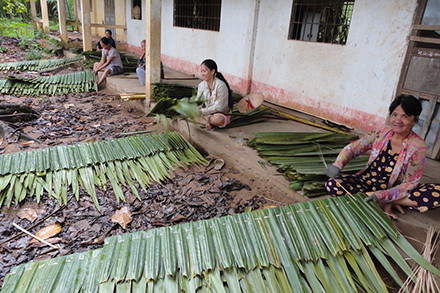In Vietnam, Binh Phu is the poorest commune in the Cang Long district in the Trà Vinh province. While Vietnam has made significant progress toward ending poverty in the past few years, many of the people in Binh Phu are still struggling with hunger and little or no income.
Then Heifer arrived. In 2011, Binh Phu was one of the two communes selected for the Improving Livelihood in the Poorest District of Trà Vinh Province project. When the project was first began, progress was slow. The local people were not familiar with the concept of joining a self-help group (SHG), group meetings and group saving funds. So many of them were absent from meetings. Also, since most of the group leaders were male, women did not feel comfortable sharing ideas or joining discussions during meetings.
Everything changed after Heifer provided training on the 12 Cornerstones for Just and Sustainable Development. The cornerstones, combined with group management tools, produce production techniques and through celebrating project activities such as International Women’s Day, International Children’s Day and the Mid-Autumn festival—things began to get exponentially better. Group members began to see the importance of unity within their community. Women in the groups became more confident speaking their opinion and many were even selected to become members of group and project management committees (PMC).
Through group activities, members could share their experiences with each other about all the news things they were learning and what was going on in their lives.. These discussions and activities persuaded other people in the community to become group members. As the group grew, the local government began to appreciate the SHGs more and more. This type of strong networking and group building is part of Heifer’s efforts to create impact by building social capital.

Another activity in the project to build social capital involves forming labor units, small groups of SHG members that help other members by contributing labor when needed. The idea was born out of the constant need for poor farmers to have extra help when it is time to harvest crops or build houses. To employ laborers is becoming more and more expensive because many people moved to the city to work in industrial zones and labor is scarce and demanding. So labor units were formed to help SHG members fill this gap. Each unit has seven to ten people. When a member needs help harvesting crops, members of the labor unit will help him or her harvest crops for free in one day. They take turns helping each other. Labor units are used every month among group members with many kinds of work and saves member up to $60 on labor costs.
“Labor units also help build houses for elderly people in the community who are not members of the project,” Phan Van Tam, a SHG member shares. Also, since the local government cannot effectively help people with these kinds of issues, members are beginning to see the benefit of helping others in their community through these project activities.

The success of labor units has attracted new members of the community to join the SHGs. And the local government has become more involved with these groups and projects, encouraging the members to expand the model to help more residents of the commune.
Since Improving Livelihood in the Poorest District of Trà Vinh Province has been implemented, household income has improved and the relationship between group members has become stronger. The groups are also working closely with the local governments to continue creating lasting positive change for the whole commune. The labor unit project foundation demonstrates not only the creativeness, willingness and ingenuity of SHG members, but also the impact of social capital as a tool for lasting change.
Story and Photos courtesy of Nguyen Thi Phuong Tham
Heifer Vietnam
